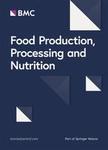Identification of zinc-binding peptides in ADAM17-inhibiting whey protein hydrolysates using IMAC-Zn^(2+) coupled with shotgun peptidomics
作者机构:Department of PlantFoodand Environmental SciencesFaculty of AgricultureDalhousie UniversityTruroNova Scotia B2N 5E3Canada Department of Chemistry and Biomolecular SciencesFaculty of ScienceUniversity of OttawaOttawaOntario K1N 6N5Canada School of Nutrition SciencesFaculty of Health SciencesUniversity of OttawaOttawaOntario K1H 8M5Canada
出 版 物:《Food Production, Processing and Nutrition》 (食物生产加工与营养(英文))
年 卷 期:2021年第3卷第1期
页 面:70-79页
核心收录:
学科分类:081704[工学-应用化学] 07[理学] 08[工学] 0817[工学-化学工程与技术] 070303[理学-有机化学] 0703[理学-化学]
基 金:supported by the Natural Sciences and Engineering Research Council of Canada(NSERC)Discovery Grants(RGPIN-435865-2013 and RGPIN-2018-06839) Canada Foundation for Innovation(CFI)John R.Evans Leaders Fund Infrastructure Grant(Project number:31305)
主 题:Zinc Zinc ligands Food protein Bioactive peptides Immobilized metal affinity chromatography Ultrafiltration ADAM17 Peptidomics Bioinformatics
摘 要:Food components possessing zinc ligands can be used to inhibit zinc-dependent *** this study,zinc-binding peptides were derived from whey protein hydrolysates,and their ultrafiltration(1 and1 kDa)fractions,produced with Esperase(WPH-Esp),Everlase and *** metal affinity chromatography(IMAC-Zn^(2+))increased the zinc-binding capacity of the peptide fraction(83%)when compared to WPH-Esp(23%)and its1 kDa fraction(40%).The increased zinc-binding capacity of the sample increased the inhibitory activity against the zinc-dependent“a disintegrin and metalloproteinase 17.LC-MS/MS analysis using a shotgun peptidomics approach resulted in the identification of 24 peptides originating from bovineβ-lactoglobulin,α-lactalbumin,serum albumin,β-casein,κ-casein,osteopontin-k,and folate receptor-αin the *** identified peptides contained different combinations of the strong zinc-binding group of residues,His+Cys,Asp+Glu and Phe+Tyr,although Cys residues were absent in the *** silico predictions showed that the IMAC-Zn^(2+)peptides were ***,the peptides possessed poor drug-like and pharmacokinetic properties;this was possibly due to their long chain lengths(5–19 residues).Taken together,this work provided an array of food peptide-based zinc ligands for further investigation of structure-function relationships and development of nutraceuticals against inflammatory and other zinc-related diseases.



